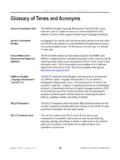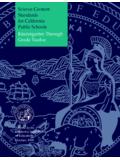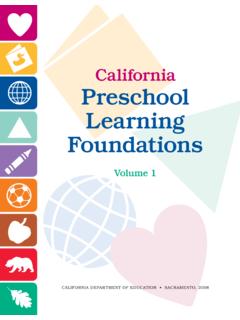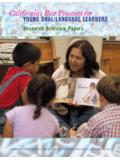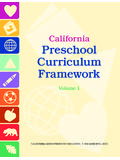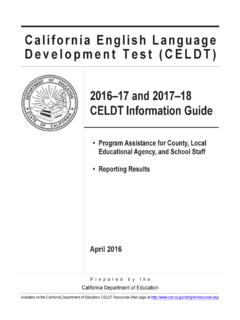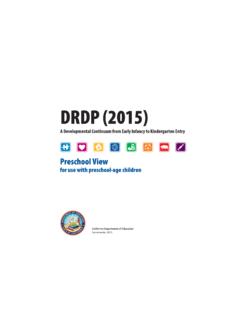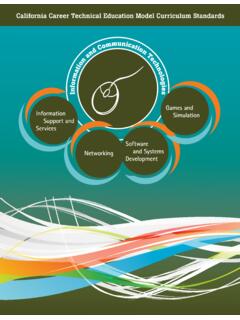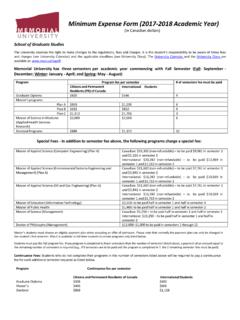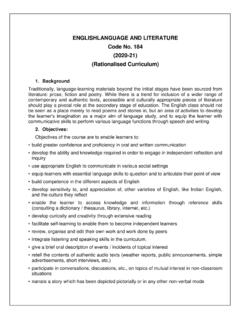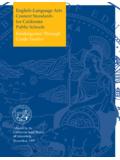Transcription of English-Language Development Standards for California ...
1 English-Language Development Standards for California Public Schools Kindergarten Through Grade Twelve Adopted by the California State Board of Education July 1999. California Department of Education Created December 20, 2002. English-Language Development Standards for California Public Schools Kindergarten Through Grade Twelve California Department of Education Created December 20, 2002. Publishing Information When the English-Language Development Standards for California Public Schools, Kindergarten Through Grade Twelve was adopted by the California State Board of Education in July 1999, the members of the State Board were the following: Robert L.
2 Trigg, President; Kathryn Dronenburg, Vice- President; Marian Bergeson; Susan Hammer; Carlton J. Jenkins; Marion Joseph; Yvonne Larsen; Monica Lozano; Janet Nicholas; Vicki Reynolds;. and Richard Weston. This publication was edited by Faye Ong, working in cooperation with Lilia G. Sanchez, Consultant, language Policy and Leadership Office. It was designed and prepared for printing by the staff of CDE Press, with the cover and interior design created and prepared by Juan D. Sanchez. Typesetting was done by Jeannette Huff. It was published by the California Department of Education, 1430 N Street, Sacramento, California (mailing address: Box 944272, Sacramento, CA 94244-2720).
3 It was distributed under the provisions of the Library Distribution Act and Government Code Section 11096. 2002 by the California Department of Education All rights reserved ISBN 0-8011-1578-7. Ordering Information Copies of this publication are available for $ each, plus shipping and handling charges. California residents are charged sales tax. Orders may besent to the California Department of Education, CDE Press, Sales Office, 271, Sacramento, CA 95812-0271; FAX (916) 323-0823. See page 90 for complete information on payment, including credit card purchases, and an order blank. Prices on all publications are subject to change. A partial list of other educational resources available from the Department appears on page 89.
4 In addition, an illustrated Educational Resources Catalog describing publications, videos, and other instructional media available from the Department can be obtained without charge by writing to the address given above or by calling the Sales Office at (916) 445-1260. Notice The guidance in English-Language Development Standards for California Public Schools, Kindergarten Through Grade Twelve is not binding on local educational agencies or other entities. Except for the statutes, regulations, and court decisions that are referenced herein, the document is exemplary, and compliance with it is not mandatory. (See Education Code Section Prepared for publication ) by CSEA members.
5 California Department of Education Created December 20, 2002. Contents California English-Language Proficiency Assessment Project .. iv Executive Summary ..1. Introduction .. 11. English-Language Development Standards ..15. Listening and Speaking ..16. Strategies and Applications ..16. Reading ..25. Word Analysis ..25. Fluency and Systematic Vocabulary Development ..36. Reading Comprehension ..48. Literary Response and Analysis ..59. Writing ..69. Strategies and Applications ..69. English-Language Conventions ..79. Selected References ..86. iii California Department of Education Created December 20, 2002. California English-Language Proficiency Assessment Project Assembly Bill 748, enacted in 1997, requires Donna Heath, San Dieguito Union High School that the test or tests assessing the progress of District english learners toward achieving fluency in Natalie Kuhlman, Teaching english to Speakers english be aligned with state Standards for of Other Languages Board English-Language Development .
6 The San Magaly Lavadenz, Loyola Marymount University Diego County Office of Education, under Barbara Merino, University of California , Davis contract with the Standards and Assessment Basha Millhollen, California Department of Division of the California Department of Education Education, named an advisory committee of Ofelia Miramontes, University of Colorado, state and national leaders to assist in the Boulder Development of the English-Language devel Alberto Ochoa, San Diego State University opment (ELD) Standards . A list of the Califor David Ramirez, California State University, Long nia English-Language Proficiency Assessment Beach Project advisory committee members and Rosalia Salinas, San Diego County Office of Education their affiliations follows: Robin Scarcella, University of California , Irvine Adel Nadeau, Chair, San Diego County Office of Education Jerome Shaw, WestEd Tim Allen, San Diego City Unified School District Leonore Spafford, Secretary, San Diego County Office of Education Bob Anderson, California Department of Educa.
7 Tion Shelly Spiegel-Coleman, Los Angeles County Office of Education Nancy Brynelson, California Department of Education Gwen Stephens, California Department of Education Frances Butler, Center for the Study of Evaluation, University of California , Los Angeles Aida Walqui, Stanford University Ruben Carriedo, San Diego City Unified School Terry Wiley, California State University, Long District Beach Richard Diaz, California Department of Education Sandy Williams, Escondido Union High School District Richard Duran, University of California , Santa Barbara Richard Wolfe, Ontario Institute for Studies in Education Mark Fetler, California Department of Education Gay Wong, California State University, Los Sara Fields, California Association of Teachers of Angeles english to Speakers of Other Languages Charlene Zawacki, Escondido Union School Jim Grissom, California Department of Education District Elizabeth Hartung-Cole, Long Beach Unified School District Note: The affiliations of persons named in this list were current at the time this document was developed.
8 Iv California Department of Education Created December 20, 2002. Executive Summary The following pages present a summary as they move toward full fluency in english . of the English-Language Development (ELD) The levels through which english learners Standards for each domain (listening and progress are identified as beginning, interme . speaking, reading, and writing ). The sum- diate, and advanced. For each ELD standard mary is designed to give an overview of the summary indicates the english language what students must know and be able to do arts substrand associated with it. 1. California Department of Education Created December 20, 2002. Summary LISTENING AND SPEAKING.
9 Strategies and Applications english language arts substrand Beginning ELD level*. Comprehension Answer simple questions with one- to two-word responses. Respond to simple directions and questions by using physical actions and other means of nonverbal communication ( , matching objects, pointing to an answer, drawing pictures). Begin to speak with a few words or sentences by using a few standard english grammatical forms and sounds ( , single words or phrases). Use common social greetings and simple repetitive phrases indepen . dently ( , Thank you, You're welcome ). Ask and answer questions by using phrases or simple sentences. Retell stories by using appropriate gestures, expressions, and illustra.
10 Tive objects. Organization and Begin to be understood when speaking, but usage of standard english Delivery of Oral grammatical forms and sounds ( , plurals, simple past tense, Communication pronouns [he or she]) may be inconsistent. Orally communicate basic personal needs and desires ( , May I go to the bathroom? ). english language arts substrand Intermediate ELD level*. Comprehension Ask and answer instructional questions by using simple sentences. Listen attentively to stories and information and identify important details and concepts by using both verbal and nonverbal responses. Ask and answer instructional questions with some supporting ele.

